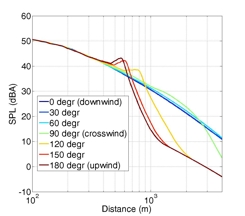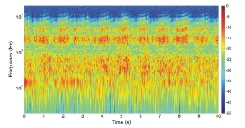Wind turbine sound propagation
Unlike most other environmental noise sources, wind turbine sound is generated at high altitude. Sound propagation experience from e.g. industrial noise sources or road traffic noise cannot be directly transfered. There is hardly any shielding and the ground effect is minimal. Due to momentum extraction, specific wind profiles appear.
Offshore piling noise
Off-shore positioning of wind turbines is a good practice since during normal operation, they will not annoy people on shore ("Propagation distance-of-concern for offshore wind turbine airborne sound during piling and normal operation", T. Van Renterghem, L. Dekoninck, D. Botteldooren; Proceedings of Forum Acusticum 2014, Krakau, Poland). However, care is needed during construction. Piling noise caused by driving a wind turbine pole in the seabed leads to extremely high sound pressure levels in the water column, and is known to cause injury and behavioural changes in marine animals, even at large distances from the piling location.
The airborne impact has attracted less attention. However, measurements showed that maximum sound power levels could exceed 140 dBA (J. Acoust. Soc. Am. 135, 599-609, 2014). In case of wind farms less than 5 km from the shoreline, also this aspect should be considered in environmental impact assessments. The airborne sound pressure levels at a few kilometers from the piling spot are strongly dependent on the atmospheric conditions like wind speed and atmospheric stability, and also sea state (sea roughness). Variations in level up to 25 dBA were predicted in case of downwind sound propagation in an unstable atmosphere. Since a rough sea surface helps in mitigating long-distance propagation of sound, piling in some wind is predicted to be beneficial to prevent noise annoyance on shore during construction (J. Acoust. Soc. Am. 135, 599-609, 2014).
Wind turbine noise perception
An extended noise perception study (Science Tot. Env. 456-457, 333-345, 2013) revealed that people in an indoor environment, unaware of the presence of wind turbine noise, are not more noise annoyed than e.g. during exposure to road traffic noise. However, persons perform extremely well in detecting wind turbine noise submersed in highway noise once they know it is present; the detection limit could be as low as - 23 dBA (Science Tot. Env. 456-457, 333-345, 2013).
This finding limits the potential of masking wind turbine noise by constructing wind farms near roads (Science Env. Pol., 47, 2015). The specific features related to the wind turbine noise spectrum and dynamics might be responsible for that. Noticing the sound is an important aspect of wind turbine noise annoyance at the low equivalent sound pressure levels typically observed in practice. It can be concluded that wind turbine noise cannot be treated as just another environmental noise source, and that low exposure levels do not guarantee the absence of noise annoyance.
Infrasound
Wind turbines produce a considerable amount of energy in the infrasonic frequency range. Although such sound waves might not be directly audible, they are suspected to interact with our hearing system. In addition, such low frequent sound waves could cause a vibratory and/or oppressive feeling in the human body. A small fraction of the population is thought to be very sensitive to such exposure. Another problem is that infrasound is able to easily propagate through the environment, in contrast to audible sound.
A first step to evaluate the relevance of infrasound is a good measurement methodology. A major issue is that such low-frequencies will be largely excited by placing a microphone in a wind flow (so-called microphone-induced wind noise), which is not the true contribution from the wind turbine. A hemi-spherical dome consisting of windbreak textile with an optimized porosity was therefore developed to be placed over the microphone. The effect of turbulent eddies much larger than the dimensions of the structure can be mitigated. Signal-to-noise ratio improvements exceeding 15-20 dB can be obtained in the infrasonic frequency range (Appl. Acoust. 178, 108015, 2021).
More than one year of measurements with such a dome showed that infrasound production (near a 2.3MW wind turbine on flat terrain) is mainly influenced by mean wind speed, turbulence intensity and turbulent vertical heat flux in the atmopheric boundary layer (J. Wind Eng. Ind. Aerodyn. 225, 105021, 2022).
Figure 1
Predicted wind turbine sound pressure level in function of distance (single wind turbine). Sound propagation in various directions is calculated. (from "Wind turbine noise propagation – results of numerical modelling techniques to investigate specific scenarios", J. Sims, A. Bullmore, T. Van Renterghem, K. Horoshenkov; Proceedings of Wind Turbine Noise 2015, Glasgow, UK.)

Figure 2
Measured spectrogram (time-frequency plot) at 30 m distance from the pole of a wind turbine operating at maximum rpm. Levels have been normalized to the maximum level at all times and frequencies.
